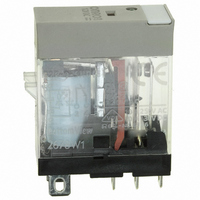G2R-1-SND-DC12(S) Omron, G2R-1-SND-DC12(S) Datasheet - Page 13

G2R-1-SND-DC12(S)
Manufacturer Part Number
G2R-1-SND-DC12(S)
Description
RELAY SPDT 12VDC PLUG-IN W/LED
Manufacturer
Omron
Series
G2RSr
Datasheets
1.G2R-1A-E-DC12.pdf
(30 pages)
2.G2R-1A-E-DC12.pdf
(14 pages)
3.G2R-1-S_DC12S.pdf
(12 pages)
Specifications of G2R-1-SND-DC12(S)
Relay Type
General Purpose
Contact Form
SPDT (1 Form C)
Contact Rating (current)
10A
Switching Voltage
440VAC, 125VDC - Max
Coil Type
Standard
Coil Current
43.2mA
Coil Voltage
12VDC
Turn On Voltage (max)
8.4 VDC
Turn Off Voltage (min)
1.8 VDC
Mounting Type
Socket
Termination Style
Quick Connect - .187" (4.7mm)
Circuit
SPDT (1 Form C)
Contact Rating @ Voltage
10A @ 250VAC
Control On Voltage (max)
8.4 VDC
Control Off Voltage (min)
1.8 VDC
Coil Voltage Vdc Nom
12V
Contact Current Max
10A
Contact Voltage Ac Nom
250V
Contact Voltage Dc Nom
30V
Coil Resistance
278ohm
Contact Configuration
SPDT
Lead Free Status / RoHS Status
Lead free / RoHS Compliant
Other names
G2R-1-SNDDC12(S)
G2R-1-SNDDC12(S)
G2R1SNDDC12S
Z2952
G2R-1-SNDDC12(S)
G2R1SNDDC12S
Z2952
Available stocks
Company
Part Number
Manufacturer
Quantity
Price
Company:
Part Number:
G2R-1-SND-DC12(S)
Manufacturer:
Omron Electronics Inc-IA Div
Quantity:
135
■ Contacts
The contacts are the most important constituent of a relay. Their
characteristics are significantly affected by factors such as the mate-
rial of the contacts, voltage and current values applied to them (espe-
cially, the voltage and current waveforms when energizing and de-
energizing the contacts), the type of load, operating frequency, atmo-
sphere, contact arrangement, and bounce. If any of these factors fail
to satisfy predetermined values, problems such as metal deposition
between contacts, contact welding, wear, or rapid increase in the
contact resistance may occur.
Switching voltage (AC, DC)
When a relay breaks an inductive load, a fairly high counterelectro-
motive force (counter emf) is generated in the relay’s contact circuit.
The higher the counter emf, the greater the damage to the contacts.
This may result in a significant decrease in the switching capacity of
DC-switching relays. This is because, unlike the AC-switching relay,
the DC-switching relay does not have a zero-cross point. Once arc
has been generated, it does not easily diminish, prolonging the arc
time. Moreover, the unidirectional flow of the current in a DC circuit
may cause metal degradation to occur between contacts and the
contacts to wear rapidly (this is discussed later).
Despite the information a catalog or data sheet sets forth as the
approximate switching power of the relay, always confirm the actual
switching power by performing a test with the actual load.
Switching Current
The quantity of electrical current which flows through the contact
directly influences the contact’ characteristics. For example, when
the relay is used to control an inductive load such as a motor or a
lamp, the contacts will wear faster, and metal decomposition
between the mating contacts will occur more often as the inrush cur-
rent to the contacts increases. Consequently, at some point the con-
tacts may weld.
Electromechanical Relays
Contact Materials
Selection of an appropriate contact material according to the load to
be opened or closed is important. Several contact materials and their
properties are listed below.
P. G. S.
Alloy
AgPd
Ag
AgNi
AgSnIn
AgSnO
AgW
2
Technical Information
This material has excellent corrosion resistance and is
suitable for very small current circuits.
(Au : Ag : Pt = 69 : 25 : 6)
This material exhibits good corrosion and sulphur resis-
tance. In a dry circuit, it attracts organic gas to generate
a polymer, therefore it is usually plated with gold or oth-
er material.
This material has the highest electric and heat conduc-
tivities among all metals. It exhibits low contact resis-
tance, but easily forms sulfide film in a sulfide gas
environment. This may result in defective contact per-
formance at a low-voltage small-current operation.
This material exhibits the same high electric conductiv-
ity as silver and excellent arc resistance.
This material exhibits excellent deposition resistance
and exhaustion resistance.
This material exhibits excellent deposition resistance. It
easily forms sulfide film in a sulfide gas environment,
same as Ag contact material
This material exhibits a high hardness and melting
point. It also exhibits excellent arc resistance and supe-
rior resistance to deposition and transfer. However, it
shows high contact resistance and inferior environmen-
tal resistance.
Examples of Contact Materials
13


















